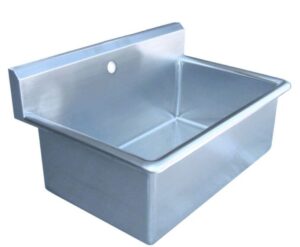
The design of sinks is optimized for safe and effective use in operating rooms and other medical environments where sterile techniques are required. These sinks feature seamless construction with rounded internal corners to prevent the accumulation of dirt and bacteria. The sink basin is deep to allow for complete submersion of hands and forearms during scrubbing. Antimicrobial materials like stainless steel are commonly used in surgical sink construction to resist microbial growth and enable easy cleaning and disinfection.
Ergonomic faucets with wrist blade, knee or foot pedal controls are installed to minimize direct contact with handles or surfaces during scrubbing. Water temperature and flow are precisely regulated. Antiscald devices keep water at a safe temperature range. Drains have self-priming pumps to remove dirty water quickly without residual standing liquids. LED lighting around the mirror provides shadow-free visibility. All of these design elements work together to facilitate proper handwashing technique per clinical protocols.
Benefits in the Operating Room
Surgical sinks play a crucial hygienic role in operating rooms by enabling clinicians to follow strict hand hygiene protocols before procedures. Effective scrubbing removes transient skin microbes and decreases bacterial counts on the hands and arms. This lowers the risk of surgical site infections, a costly and sometimes life-threatening complication. Conveniently located sinks allow surgical teams to scrub just prior to “scrubbing in,” maintaining sterility throughout the case.
Leakproof and thoroughly drainable construction prevents contaminated water from pooling around sinks. Antimicrobial surfaces coupled with integrated lighting enhance the ability to visually inspect hands for residual debris post-scrubbing. Automatic controls minimize contact that could transfer microbes between hands and faucet surfaces during scrubbing cycles. Well-designed sinks thereby support consistent adherence to aseptic technique standards in operating rooms.
Meeting Regulatory Standards
Regulations in healthcare settings mandate certain features and performance criteria for sinks used during surgical hand preparation. The Occupational Safety and Health Administration (OSHA), Centers for Disease Control and Prevention (CDC), and Association of periOperative Registered Nurses (AORN) provide guidelines that shape surgical sink design standards.
Compatibility with antiseptic skin preparations containing compounds like chlorhexidine and iodine is required. Integrated water temperature controls deliver tepid water proven most effective for degerming. Self-contained water systems eliminate cross-contamination risks from external plumbing. Seamless construction and absence of cracks or crevices prevents the harboring of microbes. Antimicrobial and non-porous materials support rigorous cleaning protocols between cases. Proper positioning near scrub areas and certification or listing by a third party standards body demonstrate regulatory compliance. Surgical sinks bearing these attributes help operating rooms meet Joint Commission accreditation requirements.
Selecting the Right Sink
Various factors determine the optimal surgical sink choice for a given operating room or procedure area. Capacity depends on team size – some models accommodate up to six simultaneous users. configurations include single, double or triple bowl designs. Motion-activated versus pedal controls cater to individual preference. Installation requirements like physical space, plumbing and electrical connections also influence the selection process.
Commercial grade construction rated for high traffic environments adds longevity. Integrated features like backsplash guards, mirrors and supply cabinets for disposables customize functionality. Touchless technologies offer further protection from pathogen transmission. Mobile sink systems enable flexible positioning near multiple operating tables. Sink selection is informed by usage patterns, budgets and compliance needs to deliver the right solution for safe and efficient surgical environments. Medical planners consult manufacturer specifications and healthcare designers to specify the best surgical sink model.
Maintenance and Cleaning
Proper maintenance keeps sinks in operating rooms and other sterile areas functioning optimally over their usable lifespan. Daily cleaning involves washing exterior surfaces and sink basin interiors with hospital-grade germicidal detergents approved for use on antimicrobial substrates. Automatic sink systems have internal flushing cycles. Sink drains and overflow outlets require periodic disinfection and flushing to remove accumulation.
Periodic maintenance tasks include inspecting plumbing connections for leak testing, checking temperature/flow regulators and replacing worn components as preventive care. Deep cleaning using chemical sterilization methods helps dissolve tougher soils. Proper documentation verifies maintenance according to manufacturer and accrediting body guidelines. Regular inspection and scheduled servicing by field technicians sustain peak performance and product warranty eligibility over the long run. Comprehensive sink care ensures hygienic reliability critical to infection control.
In summary, thoughtfully designed surgical sinks provide operating rooms with essential infrastructure supporting aseptic technique and surgical safety. Ergonomic features, antimicrobial construction qualities and compliance with regulatory standards enable proper hand hygiene protocols before invasive procedures. Selecting the right sink model tailored for specific usage benefits patient outcomes by minimizing infection risk throughout the surgical experience. With regular maintenance, sinks remain a dependable backbone of infection prevention programs in healthcare settings over time.
*Note:
1. Source: Coherent Market Insights, Public sources, Desk research
2. We have leveraged AI tools to mine information and compile it
